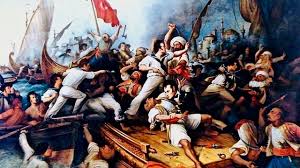For International Talk Like A Pirate Day, we present the second part of this article. Part 1 can be found here.
When peace was declared with England’s enemies, privateers at a loose end slipped easily into straightforward piracy. In 1609, Captain Thomas Salkeld, a heavy-drinking reprobate from Barnstaple, became known as the Pirate King of Lundy, after seizing the island and enslaving prisoners from captured shipping. Despite many bitter experiences in the 1620s, Barnstaple gave licence to 8 shipowners, who between them operated 14 ships. Whatever measures were employed were very unsuccessful. in ending the chaotic mayhem in the Bristol Channel. in 1627, another illegal occupier of the Isle of Puffins was Jan Janszoon, a Dutch renegade who hoisted an Ottoman flag over his ill-gotten occupation.
In 1627, a ship’s boy from Minehead, whose name, unfortunately, was not recorded, was captured by raiding “Turks” (as we saw in part 1, the name “Turks” was applied indiscriminately to people from North Africa and the Near East). He was taken to Algiers, pressed into service, and forcibly converted to Islam. He was eventually freed at sea by an English warship, still wearing Muslim attire. He was chastised by local clergy for not becoming a martyr to his faith, and made to undergo a service of penance by local clergy. On a Sunday in May 1628, he was apparently subjected to long, pedantic and, to him, incomprehensible sermons by priests from Bagborough and Luccombe, under the watchful eye of the Bishop of Bath and Wells.
In 1649, Robert Blake, the redoubtable Parliamentary defender of Taunton in the Civil War, was appointed Admiral by Cromwell. In that same year, the depredations of the Barbary pirates was so severe that it was enacted that one shilling in every pound paid in customs duty was to be allocated to the redemption of captives.
Earlier in 1646, there had been negotiations in Algiers led by Edmond Cason, a representative of the Barbary Company. to purchase the release of 244 prisoners of the Bey. These negotiations were followed by the treacheries, misunderstandings and violations which then characterised the politics of both Christian and Muslim powers in the Mediterranean.
Blake’s duties in the Mediterranean initially focussed on warfare with the Dutch, and a watching brief on the likely hostile acts of both France and Spain, However, when Blake learned in 1654 of a great concentration of Corsair vessels at Tunis, he requested authority to “sieze, surprise and sink and destroy all ships belonging to the King of Tunis that we shall meet.” He “stayed not for an answer”, but arrived at La Goulette, the port of Tunis, on 7 February 1655. There he found no great concentration of ships, and his requests to the ruling Bey for the return of the captured ship Princess and the release of captives were rudely refused. After some reconnoitring and revictualling in Sicily, he located nine well-protected Corsair ships at Porto Farina, a Tunisian arsenal, and these he set effectively on fire, destrying all with the loss of only 25 English lives.
It is almost impossible to comprehend the mixture of appeasement and aggression used in relations with the Corsair ports. Sometimes England had recognized consular officials operating in places like Algiers at the same time as captured English slaves were being tortured in nearby prisons. In 1628, soon after the accession of Charles I, a royal proclamation was issued demanding that the Corsair ports and their ships shuld be immune from any attacks by English vessels. This craven surrender excited enormous indignation in suffering ports such as Exeter, Plymouth and Dartmouth. One petition blamed the Jews who financed many lucrative piratic operations from North Africa. Seemingly no faith was entirely unable to avoid being drawn into the conflict.
As the Stuart monarchs Charles II and James I were keen sailors, and in James’s case a competent admiral, it must have been especially irksome that their efforts to deal with the problem were largely unsuccessful. However, during Charles’s reign, in 1675, a naval expedition led by Rear-Admiral Sir John Narborough managed to negotiate a treaty with Tunis, and to bombard Tripoli into submission.
Fot the next century, British ships were largely protected from the depredations of Barbary corsairs. But once the United States of America broke free from British rule, they lost the protection that went with it. In 1784, Morocco, which had been the first nation to recognise the USA, became the first nation to sieze one of its vessels, the brigantine Betsey. The Spanish government managed to negotiate the release of the hostages, but the repercussions lead to the realisation that the US Revenue-Marine (forerunner to the present-day coastguard) was not sufficient to protect American maritime interests, and to the foundation in 1794 of the US Navy. The navy fought two wars against the Barbary states, the first from 1801-5 and the second in 1815. It was an English Vice-Admiral, Edward Pellew, who eventually subdued them, though. In 1816, he led a fleet of British and Dutch warships in a bombardment of Algiers, which secured the release of some 1200 Christian slaves. For this, he was created the 1st Viscount Exmouth, thus bringing the Wessex connection full-circle.

